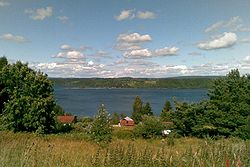Trøgstad
| Trøgstad kommune | |||
|---|---|---|---|
| Municipality | |||
 |
|||
|
|||
 Trøgstad within Østfold |
|||
| Coordinates: 59°39′5″N 11°20′23″E / 59.65139°N 11.33972°ECoordinates: 59°39′5″N 11°20′23″E / 59.65139°N 11.33972°E | |||
| Country | Norway | ||
| County | Østfold | ||
| Administrative centre | Skjønhaug | ||
| Government | |||
| • Mayor (2007) | Tor Melvold (Ap) | ||
| Area | |||
| • Total | 204 km2 (79 sq mi) | ||
| • Land | 188 km2 (73 sq mi) | ||
| Area rank | 328 in Norway | ||
| Population (2004) | |||
| • Total | 4,953 | ||
| • Rank | 193 in Norway | ||
| • Density | 284.646/km2 (737.23/sq mi) | ||
| • Change (10 years) | 3.5 % | ||
| Demonym(s) | Trøgsting | ||
| Time zone | CET (UTC+1) | ||
| • Summer (DST) | CEST (UTC+2) | ||
| ISO 3166 code | NO-0122 | ||
| Official language form | Bokmål | ||
| Website | www |
||
|
|
|||
Trøgstad is a municipality in Østfold county, Norway. The administrative centre of the municipality is the village of Skjønhaug. The municipality is divided into the parishes of Skjønhaug, Havnås and Båstad. The parish of Trygstad was established as a municipality on 1 January 1838 (see formannskapsdistrikt).
The scene of the crime for the World War II-era Feldmann case is at Skrikerudtjernet in Trøgstad.
The municipality (originally the parish) is named after the old Trøgstad farm (Old Norse: Þrygsstaðir and/or Þrjúgsstaðir), since the first church was built here. The meaning of the first element is not known (maybe a male nickname) and the last element is staðir which means "homestead" or "farm". Prior to 1889, the name was written "Trygstad".
The coat-of-arms is from modern times. They were granted on 24 August 1979. The arms show an anvil and was chosen because Trøgstad historically was well known for the quality of its blacksmiths what made iron tools and objects. The green background of the shield symbolizes the fields and forests in the municipality. The arms were designed by Truls Nygaard. (See also coat-of-arms of Hol)
Trøgstad Church (Trøgstad kirke) is a medieval era, stone church. It belongs to Østre Borgesyssel deanery in Diocese of Borg. The church is located on a ridge south of Øyeren. The church is of Romanesque architecture and has a rectangular nave with a lower and narrower choir.
...
Wikipedia


